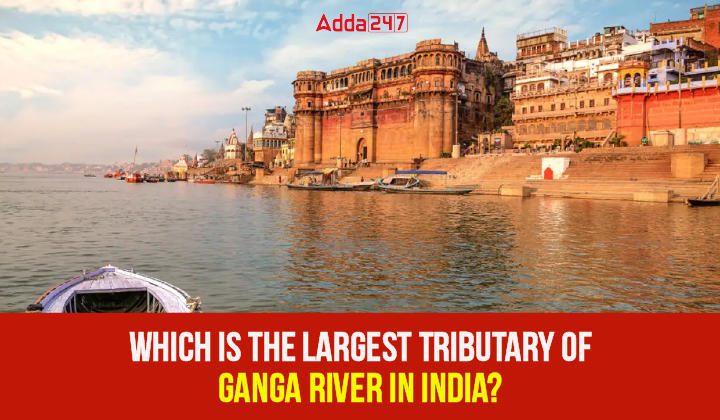Table of Contents
The Ganga happens to be India’s most significant river with regard to its basin and cultural significance. Its emergence is from the Gangotri glacier close to Gaumukh (3,900 meters), in the Uttarkashi district of Uttarakhand. Here, it is known as the Bhagirathi. Among the important tributaries of the Ganga are Ramganga, Gomati, Ghaghara, Gandak, Kosi, and Mahanada. The river finally empties into the Bay of Bengal near the very popular Sagar Island.
Ganga River in India
The Central and Lesser Himalayas have been formed through narrow canyons created by the Ganga. The Bhagirathi becomes the Ganga when it joins the Alaknanda close to Devprayag. The Alaknanda originates from the Satopanth glacier, which is situated above Badrinath. The Alaknanda is made up of the Dhauli and the Vishnu Ganga, which meet at Joshimath or Vishnu Prayag. At KarnaPrayag, the Pindar and other Alaknanda tributaries join it, and Rudra Prayag is where Mandakini or the Kali Ganga joins.
It flows from Haridwar first to the south, then to the south-east and east, and then splits into two distributaries, the Bhagirathi and the Hugli. The Ganga river has a length of 2,525 kilometers. It is shared by Bihar (445 km), West Bengal (520 km), Uttar Pradesh (1,450 km), and Uttarakhand (110 km). The Ganga basin covers an area of about 8.6 lakh square kilometres in India alone. The Ganga river system is the biggest in India, with a number of perennial and non-perennial rivers that come from the Peninsula in the south and the Himalayas in the north, respectively.
Largest Tributary of the Ganga Overview
- The largest tributary of the Ganga river is the Yamuna.
- The Yamuna originates from the Lower Himalayas in Uttarakhand’s Yamunotri Glacier.
- It traverses a total of 1,376 kilometers before joining the Ganga at Triveni Sangam or Prayag in Allahabad.
- The Hindan, the Rind, the Sengar, the Varuna, and a few others join the left bank of the Yamuna.
- The Chambal, the Sind, the Betwa, and the Ken join the right bank of the Yamuna. These rivers originate from the peninsular plateau.
- The western, eastern, and Agra canals receive a significant amount of water from the Yamuna for irrigation purposes.
- The word Yamuna means twins in Sanskrit and is a translation from the Indian language.
- The Rig Veda and the Atharva Veda, two Hindu religious texts, make references to the Yamuna river.
- The holy Bhagavad Gita was dictated to Arjun by the Hindu god Krishna during the Battle of Kurukshetra, and Krishna’s birth is also associated with the Yamuna River.
Importance of Yamuna River
The Taj Mahal, one of the Seven Wonders of the World, is situated on the Yamuna River’s southern banks. To amplify the monument’s beauty, the Taj Mahal was constructed on its southern banks. It is one of the most popular locations for taking pictures in the evening. Many photos of the Taj Mahal have been captured alongside the Yamuna River. This location was chosen by the monument’s architect as the most fascinating one to construct it out of white marble.
- At Yamunotri, the Yamuna river has a hot water pool known as Surya Kund.
- Surya Kund is believed to be a shrine to Surya, the son of the Sun God.
- The water in Surya Kund is so hot that it is used for making tea, cooking rice, and boiling potatoes.
- The temperature of the water in Surya Kund is approximately 88 degrees Celsius.
- The rice and potatoes prepared in Surya Kund are offered to the gods and goddesses at Yamunotri Temple.
- The Yamuna river plays a crucial role in farming and agriculture in states like Haryana, Uttar Pradesh, Uttarakhand, and others.
- The river’s water is used for irrigation in agricultural regions across several North Indian states.
- Many states in North India rely on the Yamuna for clean drinking water.
- In ancient India, during the Vedic era, the water from the Yamuna was used for agriculture in the Indo-Gangetic plains.
- Multiple canals have been constructed in Indian states to supply Yamuna river water.
- The Yamuna river becomes contaminated as it approaches the Delhi-NCR region.
- Industrialization and discharge of industrial waste into the river are major contributors to water pollution.
- The Indian government launched a drive to clean the Yamuna in 1984, but the pollution has not been completely resolved.
- The 52 km section of the Yamuna River between Delhi and Uttar Pradesh has been declared a conservation zone under the Yamuna Action Plan and the National Green Tribunal Act 2014.
Overall, the article highlights the geographical, cultural, and environmental significance of the Ganga and Yamuna rivers in India, as well as the challenges they face regarding pollution and conservation efforts.



 UGC NET Notification 2025 Out, Exam Date...
UGC NET Notification 2025 Out, Exam Date...
 CSIR NET Cut Off 2025, Download Subject ...
CSIR NET Cut Off 2025, Download Subject ...
 CSIR NET Scorecard 2025 Out, Download Re...
CSIR NET Scorecard 2025 Out, Download Re...














